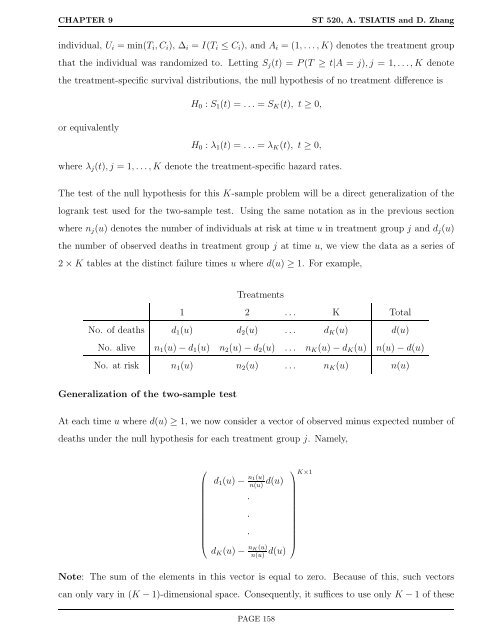ST 520 Statistical Principles of Clinical Trials - NCSU Statistics ...
ST 520 Statistical Principles of Clinical Trials - NCSU Statistics ...
ST 520 Statistical Principles of Clinical Trials - NCSU Statistics ...
Create successful ePaper yourself
Turn your PDF publications into a flip-book with our unique Google optimized e-Paper software.
CHAPTER 9 <strong>ST</strong> <strong>520</strong>, A. TSIATIS and D. Zhang<br />
individual, Ui = min(Ti, Ci), ∆i = I(Ti ≤ Ci), and Ai = (1, . . .,K) denotes the treatment group<br />
that the individual was randomized to. Letting Sj(t) = P(T ≥ t|A = j), j = 1, . . ., K denote<br />
the treatment-specific survival distributions, the null hypothesis <strong>of</strong> no treatment difference is<br />
or equivalently<br />
H0 : S1(t) = . . . = SK(t), t ≥ 0,<br />
H0 : λ1(t) = . . . = λK(t), t ≥ 0,<br />
where λj(t), j = 1, . . .,K denote the treatment-specific hazard rates.<br />
The test <strong>of</strong> the null hypothesis for this K-sample problem will be a direct generalization <strong>of</strong> the<br />
logrank test used for the two-sample test. Using the same notation as in the previous section<br />
where nj(u) denotes the number <strong>of</strong> individuals at risk at time u in treatment group j and dj(u)<br />
the number <strong>of</strong> observed deaths in treatment group j at time u, we view the data as a series <strong>of</strong><br />
2 × K tables at the distinct failure times u where d(u) ≥ 1. For example,<br />
Treatments<br />
1 2 . . . K Total<br />
No. <strong>of</strong> deaths d1(u) d2(u) . . . dK(u) d(u)<br />
No. alive n1(u) − d1(u) n2(u) − d2(u) . . . nK(u) − dK(u) n(u) − d(u)<br />
No. at risk n1(u) n2(u) . . . nK(u) n(u)<br />
Generalization <strong>of</strong> the two-sample test<br />
At each time u where d(u) ≥ 1, we now consider a vector <strong>of</strong> observed minus expected number <strong>of</strong><br />
deaths under the null hypothesis for each treatment group j. Namely,<br />
⎛<br />
⎜<br />
⎝<br />
d1(u) − n1(u)<br />
n(u) d(u)<br />
·<br />
·<br />
·<br />
dK(u) − nK(u)<br />
n(u) d(u)<br />
⎞K×1<br />
Note: The sum <strong>of</strong> the elements in this vector is equal to zero. Because <strong>of</strong> this, such vectors<br />
can only vary in (K − 1)-dimensional space. Consequently, it suffices to use only K − 1 <strong>of</strong> these<br />
PAGE 158<br />
⎟<br />
⎠
















